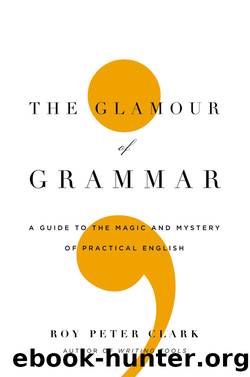The Glamour of Grammar by Roy Peter Clark & Roy Peter Clark

Author:Roy Peter Clark & Roy Peter Clark [Clark, Roy Peter]
Language: eng
Format: epub
ISBN: 978-0-316-08906-7
Publisher: Little, Brown and Company
Published: 2010-09-15T00:00:00+00:00
30
Identify all sources of ambiguity and confusion.
Poet and scholar William Empson was only twenty-four years old in 1930 when his book Seven Types of Ambiguity was published, which is why I resent him; not for the influence of his scholarship, but that so wise a study of literature should come from so young a writer. (On the flip side, I am intrigued by his roguish personal life: he was banished from Cambridge University after a housekeeper found condoms in his room.)
Ambiguity, it seems, has great value in certain discourse communities. In diplomacy, ambiguity enables compromise by inviting each side to interpret language for partisan benefit. In the famous legal decision Brown v. Board of Education, an oxymoron—“with all deliberate speed”—set the clock ticking in the hope that enlightened leaders would have the time needed for the peaceful desegregation of public schools. Opponents used the phrase to justify resistance.
In the experience of literature, ambiguity reflects a multilayered world, allowing the reader to hold on to multiple meanings at the same time. Empson defines ambiguity as “any verbal nuance, however slight, which gives room for alternative reactions to the same piece of language.” As an example, Empson offers Shakespeare’s Sonnet 73, in which an aging poet encourages his younger lover to love the older man with passion while there is still time. It begins:
That time of year thou mayst in me behold,
When yellow leaves, or none, or few, do hang
Upon those boughs which shake against the cold,
Bare ruined choirs, where late the sweet birds sang.
In the closest of close readings, Empson explores the levels of meaning generated by “bare ruined choirs.” In short, he asks, “How is an aging lover like a tree in autumn and like the ruins of a monastery?”
Here’s Empson:
The fundamental situation… is that a word or a grammatical structure is effective in several ways at once. [In the case of] “bare ruined choirs,” [the comparisons make sense at a variety of levels]: because ruined monastery choirs are places in which to sing, because they involve sitting in a row, because they are made of wood, are carved into knots and so forth, because they used to be surrounded by a sheltering building crystallised out of the likeness of a forest, and coloured with stained glass and painting like flowers and leaves, because they are now abandoned by all but the grey walls coloured like the skies of winter, because the cold and Narcissistic charm suggested by choir-boys suits well with Shakespeare’s feeling for the object of the Sonnets, and for various sociological and historical reasons (the protestant destruction of monasteries; fear of puritanism), which it would be hard now to trace out in their proportions; these reasons, and many more relating the simile to its place in the Sonnet, must all combine to give the line its beauty, and there is a sort of ambiguity in not knowing which of them to hold most clearly in mind. Clearly this is involved in all such richness and heightening of effect, and the machinations of ambiguity are among the very roots of poetry.
Download
This site does not store any files on its server. We only index and link to content provided by other sites. Please contact the content providers to delete copyright contents if any and email us, we'll remove relevant links or contents immediately.
Cecilia; Or, Memoirs of an Heiress — Volume 1 by Fanny Burney(31332)
Cecilia; Or, Memoirs of an Heiress — Volume 3 by Fanny Burney(30934)
Cecilia; Or, Memoirs of an Heiress — Volume 2 by Fanny Burney(30889)
The Lost Art of Listening by Michael P. Nichols(6472)
We Need to Talk by Celeste Headlee(4868)
Asking the Right Questions: A Guide to Critical Thinking by M. Neil Browne & Stuart M. Keeley(4574)
On Writing A Memoir of the Craft by Stephen King(4213)
Dialogue by Robert McKee(3582)
I Have Something to Say: Mastering the Art of Public Speaking in an Age of Disconnection by John Bowe(3516)
Pre-Suasion: A Revolutionary Way to Influence and Persuade by Robert Cialdini(3413)
Elements of Style 2017 by Richard De A'Morelli(2943)
The Book of Human Emotions by Tiffany Watt Smith(2770)
Good Humor, Bad Taste: A Sociology of the Joke by Kuipers Giselinde(2557)
Name Book, The: Over 10,000 Names--Their Meanings, Origins, and Spiritual Significance by Astoria Dorothy(2490)
Fluent Forever: How to Learn Any Language Fast and Never Forget It by Gabriel Wyner(2445)
The Grammaring Guide to English Grammar with Exercises by Péter Simon(2393)
Why I Write by George Orwell(2359)
The Art Of Deception by Kevin Mitnick(2297)
Don't Sleep, There Are Snakes by Daniel L. Everett(2216)
